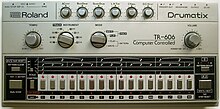| TR-606 | |
|---|---|
 TR-606 front panel | |
| Manufacturer | Roland |
| Dates | 1981–1984 |
| Technical specifications | |
| Polyphony | 7 |
| Timbrality | 7 |
| Synthesis type | Analog subtractive |
| Storage memory | 32 patterns, 8 songs |
| Effects | Individual level |
| Input/output | |
| Keyboard | 16 pattern keys |
| External control | DIN sync in/out |
The Roland TR-606 Drumatix is a drum machine built by Roland Corporation from 1981 to 1984.